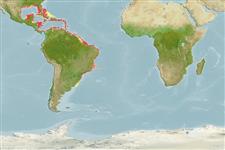>
Eupercaria/misc (Various families in series Eupercaria) >
Haemulidae (Grunts) > Haemulinae
Etymology: Anisotremus: Greek, anisos = unequal + Greek, trema, -atos = hole (Ref. 45335).
More on author: Bloch.
Environment: milieu / climate zone / depth range / distribution range
Écologie
marin récifal; profondeur 0 - 70 m (Ref. 9710), usually 0 - 15 m (Ref. 40849). Subtropical; 31°N - 35°S, 98°W - 28°W
Western Atlantic: Florida, USA and the Bahamas through the Gulf of Mexico and the Caribbean Sea to Brazil.
Taille / Poids / Âge
Maturity: Lm ? range ? - ? cm
Max length : 76.0 cm TL mâle / non sexé; (Ref. 40637); common length : 45.0 cm TL mâle / non sexé; (Ref. 3798); poids max. publié: 5.8 kg (Ref. 40637)
Épines dorsales (Total) : 12; Rayons mous dorsaux (Total) : 18; Épines anales: 3; Rayons mous anaux: 9. Front half of body darker than rear. Soft dorsal and anal fins have dense scales on bases of interradial membranes (Ref. 26938). Fins dusky, anal and pelvic fins darkest; peritoneum not black; young with two black stripes and a black spot at base of caudal fin (Ref. 13442).
Maximum depth from Ref. 126840. Inhabits larger patch reefs and quickly sloping rocky bottoms. Often near the shelter of caves, ledges, or wrecks (Ref. 9710). Feeds at night on crustaceans, mollusks, smaller fish, and the long-spined urchin, Diadema. Marketed fresh.
Life cycle and mating behavior
Maturité | Reproduction | Frai | Œufs | Fécondité | Larves
Distinct pairing during breeding (Ref. 205).
Robins, C.R. and G.C. Ray, 1986. A field guide to Atlantic coast fishes of North America. Houghton Mifflin Company, Boston, U.S.A. 354 p. (Ref. 7251)
Statut dans la liste rouge de l'IUCN (Ref. 130435: Version 2024-1)
Menace pour l'homme
Reports of ciguatera poisoning (Ref. 30303)
Utilisations par l'homme
Pêcheries: commercial; pêche sportive: oui; Aquarium: Aquariums publics
Outils
Articles particuliers
Télécharger en XML
Sources Internet
Estimates based on models
Preferred temperature (Ref.
123201): 24.2 - 26.1, mean 25.5 °C (based on 19 cells).
Phylogenetic diversity index (Ref.
82804): PD
50 = 0.5039 [Uniqueness, from 0.5 = low to 2.0 = high].
Bayesian length-weight: a=0.02042 (0.01215 - 0.03431), b=3.01 (2.86 - 3.16), in cm total length, based on LWR estimates for this species & (Sub)family-body (Ref.
93245).
Niveau trophique (Ref.
69278): 3.6 ±0.2 se; based on diet studies.
Résilience (Ref.
120179): Faible, temps minimum de doublement de population : 4,5 à 14 années (Preliminary K or Fecundity.).
Fishing Vulnerability (Ref.
59153): Moderate to high vulnerability (50 of 100).
Nutrients (Ref.
124155): Calcium = 14.9 [7.1, 40.1] mg/100g; Iron = 0.467 [0.224, 0.919] mg/100g; Protein = 19.7 [17.8, 21.7] %; Omega3 = 0.127 [0.058, 0.254] g/100g; Selenium = 15.5 [6.5, 32.4] μg/100g; VitaminA = 26.1 [7.0, 98.0] μg/100g; Zinc = 0.585 [0.354, 0.950] mg/100g (wet weight);
